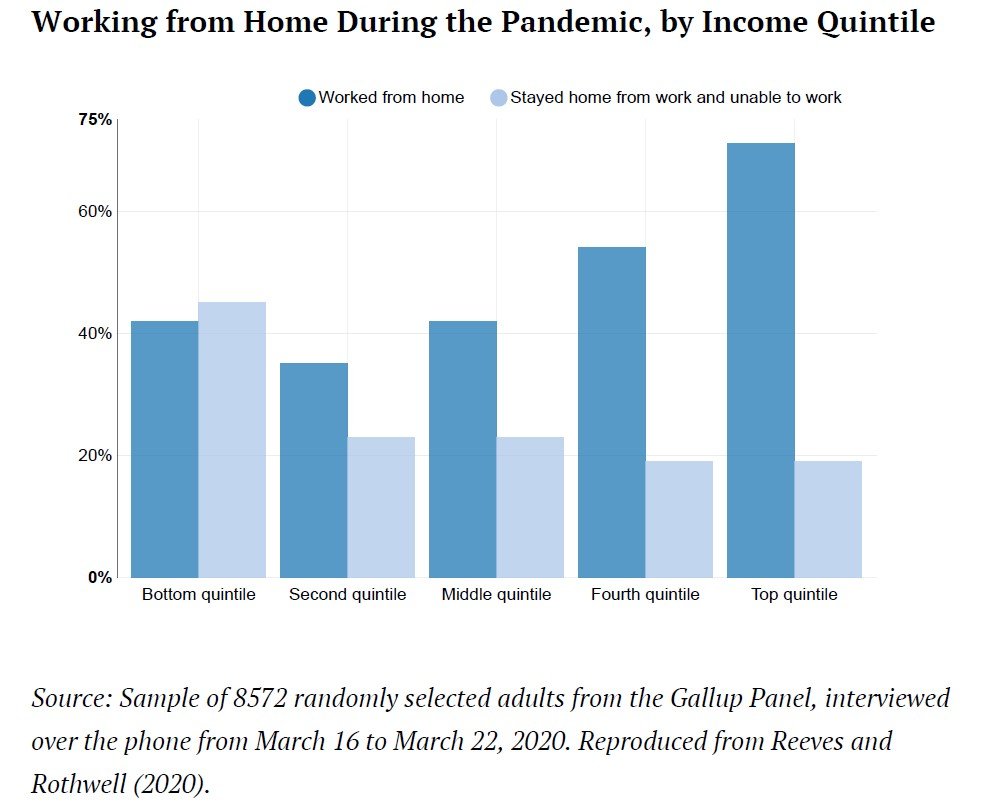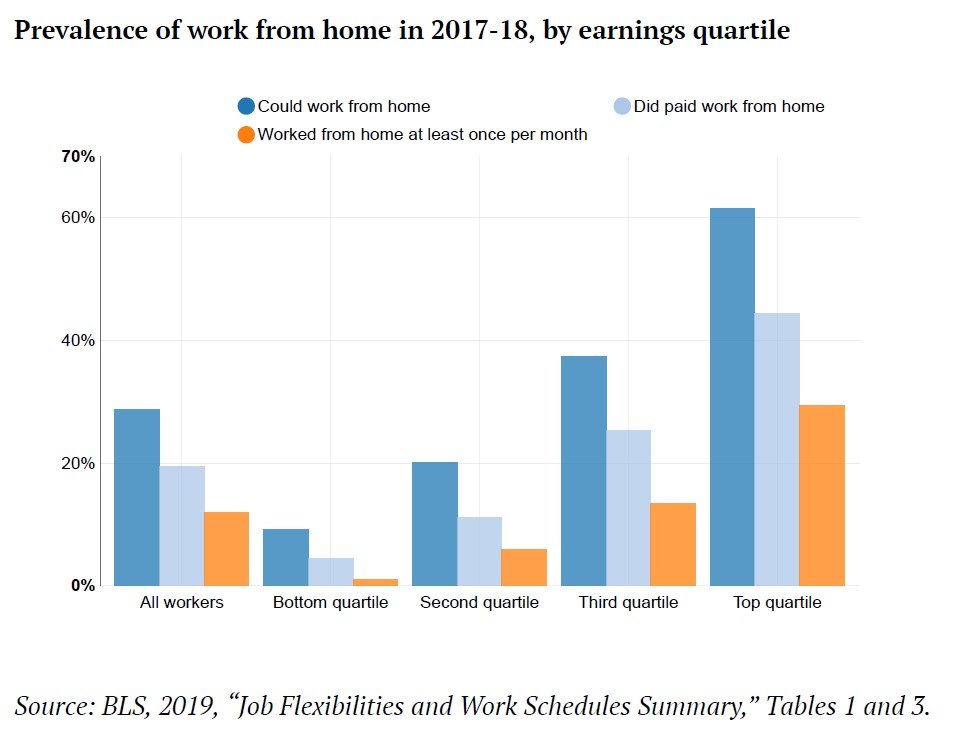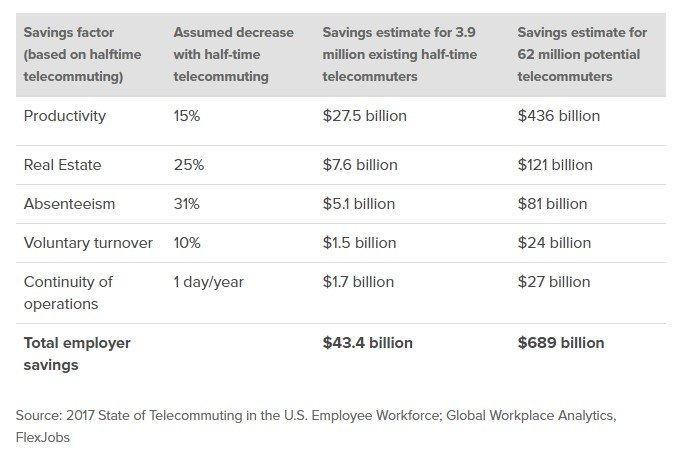As we continue with our Future of Work blog series, let’s discuss a critical element of what we are experiencing now, and will likely be a large part of the future – telecommuting (also known as virtual work). If you weren’t familiar with the idea of virtual work before the beginning of 2020, you very likely are now. In fact, a lot of people have been scrambling to go from sitting on their couches with laptops to setting up a functioning home office — all while home-schooling kids and trying to retain the feel of a house and not letting it become a branch office. But, will this just be a temporary modification, or are more companies likely to go against their previous avoidance of telework and blend this working style into their culture and policies in the future?
A lot of us have been thrust into telecommuting, but how many? Over the past few weeks, there have been some indicators, but very little hard data exists as of today. A recent article in Time Magazine (4/6/2020) presents data that 163 million Americans are under stay-at-home orders and 67% of employers have made efforts to enable employees to work from home who would normally come into the office. Additionally, many of the same income-based disparities seen in telecommuting before the pandemic are still prevalent. This chart shows that the bulk of people who were given the opportunity to work from home were from higher income brackets, while higher percentages of people in lower income brackets were forced to stay home without pay.

Lacking more concrete data, we have seen Slack’s usage from February 1 to March 18 jump 40%, Zoom’s stock price has doubled, and Microsoft Teams has jumped by 12 million daily users week over week, up to a high of 44 million. And because of the normal struggles of setting up a virtual workforce and the strain of the current pandemic, several organizations report virtual work being very challenging right now. A current best estimate is that by the end of 2021, 25-30% of the American workforce could be working from home on at least a part-time basis, multiple days per week. So, when the world returns to some semblance of normal, it is unlikely that all the 67% of employers who have set up virtual workforces in the emergency will continue telecommuting, but many of them will.
Even though some form of work-from-home has existed since the Internet really began to boom, it wasn’t necessarily widely accepted until more recently. In fact, in response to 9-11 attacks, a Congressional Report investigated working from home. According to Office of Personnel Management (OPM) data, only about 14% of all individuals who had the ability to work from home were defined as “eligible” to do so. In a 2014 Quality of Worklife Survey (QWS), 26% of people reported working from home often, but only 47% of those people actually had a formal “work from home” arrangement with their employers.
During a decade time span from 2005-2015, those who regularly worked from home only increased by 2-3%. In 2017-2018, Bureau of Labor Statistics (BLS) data showed that only one-third of workers said they had the option to work at home. Of that one-third, only 20% said they were paid to work from home, and 12% said they worked one full day per month. Additionally, those who had any sort of work-from-home relationships with their employers tended to be higher-paid professionals. About half of the top quartile had the opportunity to work from home versus only 4% in the bottom quartile. So, before the COVID-19 pandemic forced many of us into remote working, only a small percentage of people had the opportunity to work from home, and of those, most were from higher-paid, higher-profile jobs.

So, telecommuting has been available for quite some time, but businesses haven’t really embraced it until forced to by a pandemic. Why is that? Two good articles from SHRM and Entrepreneur from before the pandemic give good insight. Some of those insights bearing on our current situation include:
- Lack of Trust and Low Productivity – A lot of companies simply believed they couldn’t trust their employees to work from home and believed that without management oversight, productivity would be harmed. This has been mostly refuted by research, showing that people are actually more productive when they can define how and when they work. However, it is important to remember that people who are telecommuting right now during the COVID-19 pandemic are doing so from houses full of people also under stay-at-home orders. So, they may be impacted by also managing childcare, home-schooling and partners working from home, which could be impacting current productivity levels.
- All-or-Nothing Telecommuting – A lot of organizations believed that telecommuting must be an all-or-nothing endeavor. Some of them started telecommuting programs and then abandoned them completely at the first sign of any problems. Telecommuting can mean many things to different companies. There can be many different versions between a handful of days per year and 100% remote work. When stay-at-home restrictions have been lifted in part or in whole, organizations would do well to learn from these experiences and for the safety of their workers and their productivity, consider implementing programs that retain the best practices.
- Security Concerns – Another concern that had arisen was that of the IT security concerns with a virtual workforce. These concerns are important to consider especially with multiple major security breaches in recent years and employees using their own devices to access company networks. However, as much of a concern as it was before, these aren’t reasons to get rid of virtual work opportunities, but instead, to address the challenges and solve them with creative solutions. For example, due to the multiple stay-at-home orders, Zoom saw a massive spike in its business, and security issues became critical. Eric Yuan (CEO of Zoom) owned the problems and has been working to solve them.
- Too Costly – A lot of organizations felt that telecommuting would simply be too costly. However, there are several cost breakdowns related to the potential savings with telecommuting. There were always initial costs to set up employees with the necessary technology, and these initial costs had frequently been the barrier that caused so many organizations to balk at putting programs in place. Now, many of those initial costs will have been spent due to COVID-19, there’s reason to examine the great potential savings available with a telecommuting workforce that’s already set up with proper technology and home office spaces.

Moving toward the future, what will we have to look forward to with the likely increase in telecommuting? Politico points out that organizations will have trouble taking all virtual work back from employees who have decided they enjoy it, and virtual reality may become a bigger and stronger tool for work. Additionally, the Brookings Institute points out this need for virtual work will give rise to higher quality, more powerful broadband to support virtual workers.
Since many of us will continue to work from home, at least in some capacity, information and best practices for ourselves and anyone you manage could be helpful right now. For workers, Harvard Business Review gives some good blanket tips on how to avoid distractions, such as making sure to block your calendar in such ways to be able to stay focused and checking your email only at specific times during the day. For more specific telecommuting tips, USA today suggests things like making sure that you have a dedicated space, investing in a second computer monitor screen and establishing a routine. Prior to the COVID-19 outbreak, a friend of mine who worked remotely would get ready for work, drive to his local coffee shop to buy a coffee and then drive back home as his “commute” to work. You can do something similar now. Get your coffee and sit on your deck or patio for a few minutes to designate that time as your commute into your office. And always make sure to leave your office after you’re finished working to establish good boundaries between your “work time” and your “home time.”
For managers, Forbes has put together a list of tips about how to enable better telecommuting, such as making sure to use VPNs, Multi-Factor Authorization and using the cloud to your organization’s advantage. ZDNet has a lot of experience with remote workers and has put together a list of tips such as making sure you have KPIs you can manage, ensuring you communicate more than you would in the office, and trusting your employees to do what needs to be done and address specific behavior. A key component of trusting your employees is how you view their motivations to work. Consider a foundational theory of motivation: Theory X Theory Y. Essentially, Theory X states that employees are self-centered, dislike their work and will avoid it whenever possible. So, you need rules and controls to make sure they’re working. Theory Y assumes that people want to work, can be self-directed and they will ultimately seek responsibility. Your theory of how people work will dictate your challenges with managing a virtual team because Theory X is inherently distrustful of people, where Theory Y has a strong belief in people working because they want to work.
At this point, we’re starting to get an idea of when we might start coming out of our stay-at-home orders, but there’s really very little idea if we’ll be able to go back to the office for short or longer periods of time. Regardless, it’s very likely that the future of work will continue to involve more remote working opportunities for some jobs.
Stick with us as we move to our third blog in our 5-part series about the field of healthcare – what’s happening right now and how it might change and shift in the future based on the pandemic experiences. Then, our fourth blog will dive into an industry that we’ve all been tapping more and more: delivery and logistics. And finally, we’ll close out this series with an exploration of the tech and IT field that has been pushed to its limits and will likely take us forward into the future, touching almost every job, and providing new and expanding career opportunities.
